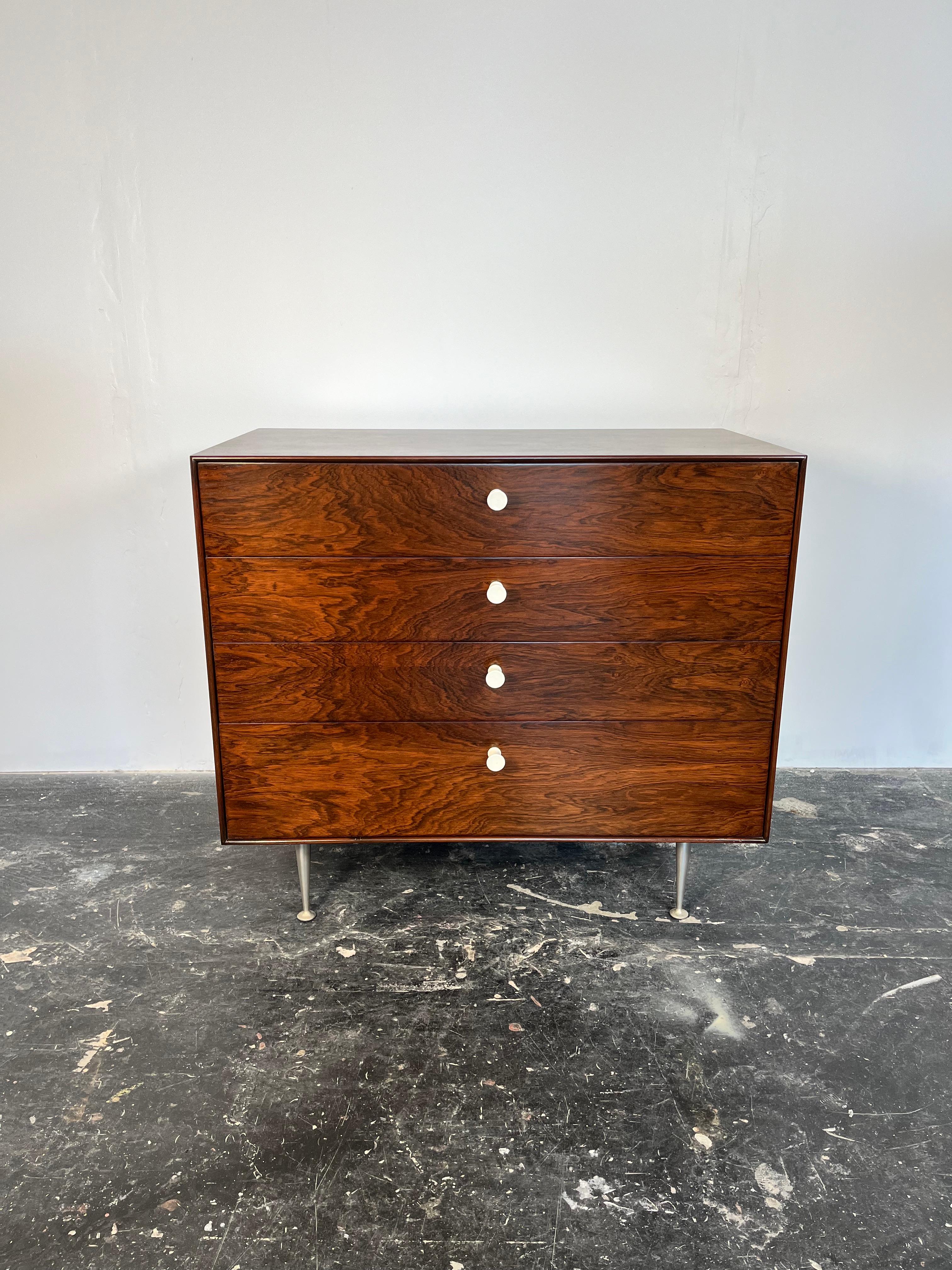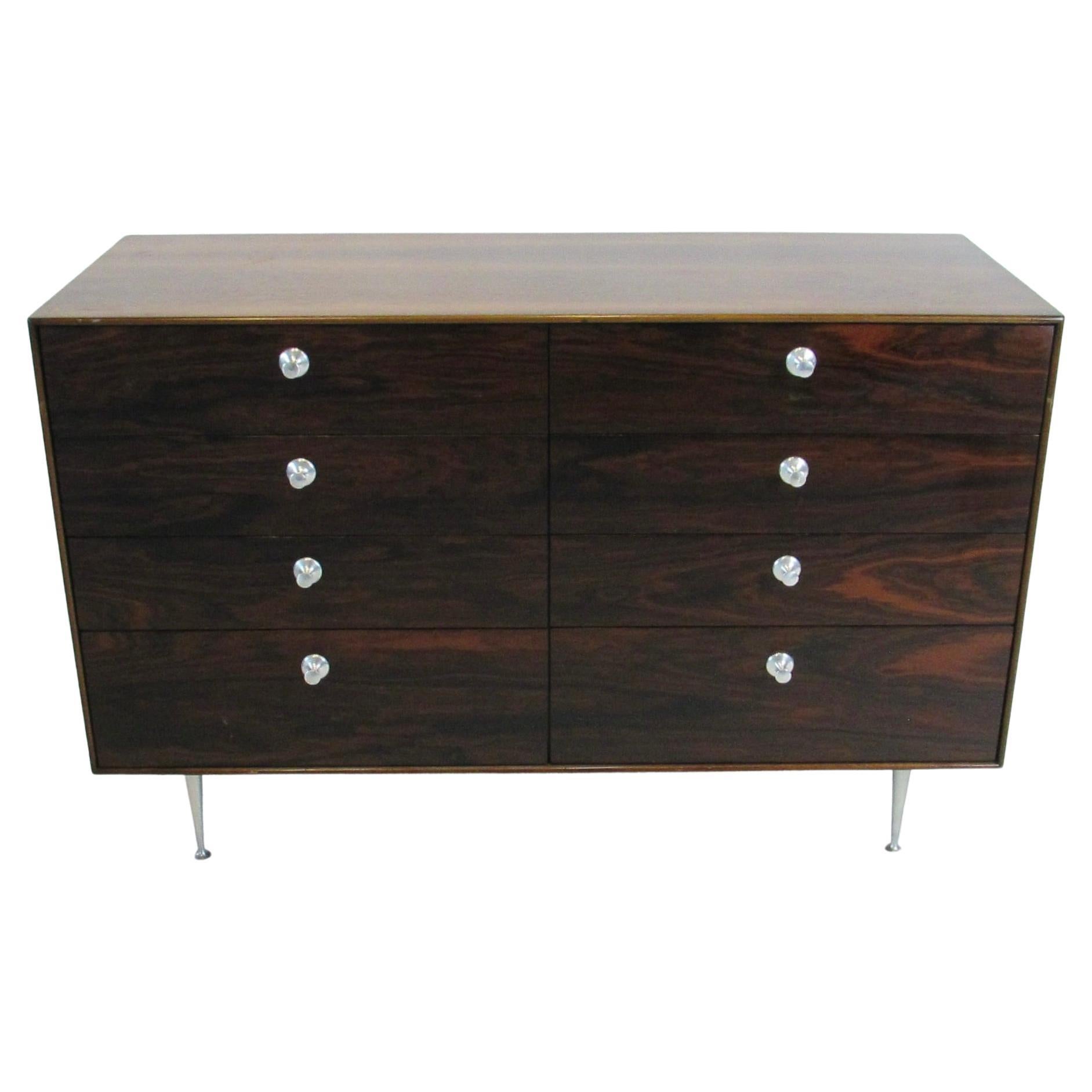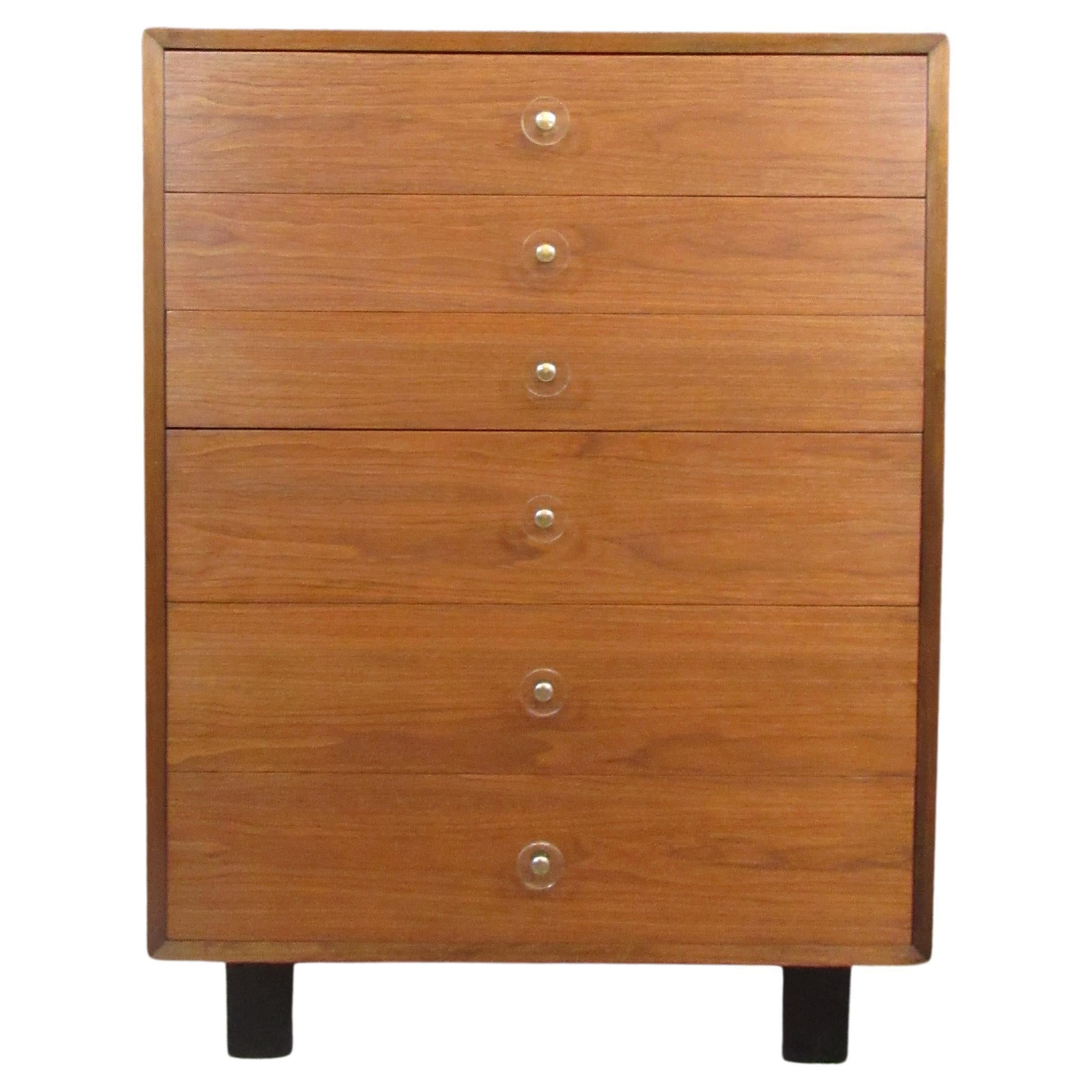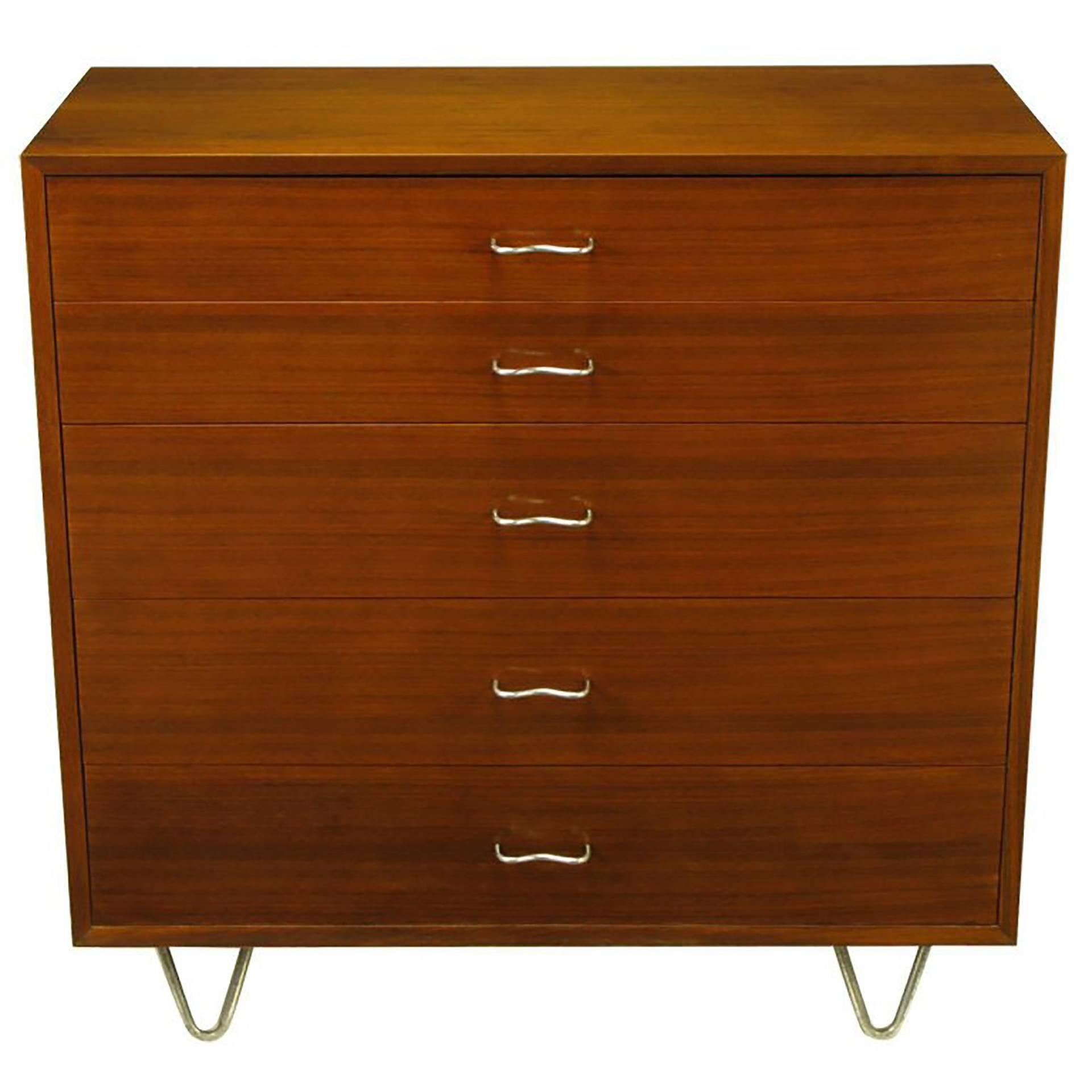George Nelson 5 Drawer Dresser with Sculptural Pulls by Herman Miller #4610
About the Item
- Creator:George Nelson (Designer)
- Dimensions:Height: 36.63 in (93.05 cm)Width: 40 in (101.6 cm)Depth: 18.5 in (46.99 cm)
- Style:Mid-Century Modern (Of the Period)
- Materials and Techniques:
- Place of Origin:
- Period:
- Date of Manufacture:1950's
- Condition:Refinished. Wear consistent with age and use. In great condition having a sympathetic restoration which leaves some of the soul and feel of a vintage piece .
- Seller Location:Cincinnati, OH
- Reference Number:1stDibs: LU925136045622
George Nelson
Architect, designer, and writer George Nelson was a central figure in the mid-century American modernist design movement; and his thoughts influenced not only the furniture we live with, but also how we live.
Nelson came to design via journalism and literature. Upon receiving his bachelor’s degree in architecture from Yale in 1931, he won the Prix de Rome fellowship, and spent his time in Europe writing magazine articles that helped bring stateside recognition to Ludwig Mies van der Rohe, Gio Ponti, Le Corbusier and other canonical modernist architects.
In the 1940s, Nelson wrote texts that suggested such now-commonplace ideas as open-plan houses, storage walls and family rooms. D.J. De Pree, the owner of the furniture maker Herman Miller, was so impressed by Nelson that in 1944 — following the sudden death of Gilbert Rohde, who had introduced the firm to modern design in the 1930s — he invited Nelson to join the company as its design director. There Nelson’s curatorial design talents came to the fore.
To Herman Miller he brought such eminent creators as Charles and Ray Eames, Isamu Noguchi, and the textile and furniture designer Alexander Girard. Thanks to a clever contract, at the same time as he directed Herman Miller he formed a New York design company, George Nelson & Associates, that sold furniture designs to the Michigan firm. Nelson's studio also sold designs for clocks to the Howard Miller Clock Company, a manufacturer that was initially part of Herman Miller before it became an offshoot that was helmed by Howard Miller, D.J. De Pree's brother-in-law.
Nelson’s New York team of designers (who were rarely individually credited) would create such iconic pieces as the Marshmallow sofa, the Coconut chair, the Ball clock, the Bubble lamp series and the many cabinets and beds that comprise the sleek Thin-Edge line.
For dedicated collectors, as well as for interior designers who look beyond “the look,” there is a “cool factor” inherent to vintage pieces from George Nelson and others. Nelson was in on it from the start, and it’s valuable to have a piece that was there with him.
But still, as is evident from the offerings from dealers on 1stDibs, in any of the designs, in any iteration whose manufacture Nelson oversaw and encouraged, there are shining elements of lightness, elegance, sophistication — and a little bit of swagger. George Nelson felt confident in his ideas about design and didn’t mind letting the world know.
- ShippingRetrieving quote...Ships From: Cincinnati, OH
- Return PolicyThis item cannot be returned.
- George Nelson Nightstands with Pull Out Tables for Herman MillerBy George NelsonLocated in Cincinnati, OHA pair of dark ebony toned Mid Century nightstands with pull out bedside table and upper and lower bookcase styled storage . A early designed by George ...Category
Mid-20th Century American Mid-Century Modern Night Stands
MaterialsWood
- George Nelson Chest / Dresser Cabinet for Herman Miller # 4935By George NelsonLocated in Cincinnati, OHA very well crafted dresser chest or cabinet standing on shorter legs in a dark ebony finish with side door having two adjustable shelves . The other side has five drawers , all with...Category
Mid-20th Century American Mid-Century Modern Cabinets
MaterialsStainless Steel
- George Nelson Prototype DAF Chair for Herman MillerBy George NelsonLocated in Cincinnati, OHAn early per production prototype fiberglass arm shell or DAF chair designed by George Nelson. This chair came directly from a engineer working for the Herma...Category
Mid-20th Century American Mid-Century Modern Chairs
MaterialsFiberglass
- George Nelson Pedestal Side Table for Herman MillerBy George NelsonLocated in Cincinnati, OHA simple and elegant pedestal side table with round top having a natural thin wood trim detail to the edge and cast meat star base . The base with foot pads to protect your floors ha...Category
Mid-20th Century American Mid-Century Modern Side Tables
MaterialsMetal
- Rare Early George Nelson Bench / Coffee Table for Herman MillerBy George NelsonLocated in Cincinnati, OHA early and rare Nelson coffee table / bench with white rectangle Laminate top having black legs typical of the Nelson slat bench coffee table. This table was not produced in large n...Category
Mid-20th Century American Mid-Century Modern Coffee and Cocktail Tables
MaterialsWood
- Slat Wood Side Tables in the styled of George Nelson and Herman MillerBy George NelsonLocated in Cincinnati, OHA pair of heavy well crafted solid maple slat wood side / end tables with satin black legs and upper shelve . A glass insert to the top gives the pieces a light clean look having bev...Category
Mid-20th Century American Mid-Century Modern End Tables
MaterialsGlass, Wood
- George Nelson Rosewood Thin Edge 4 drawer Dresser by Herman Miller #1By George NelsonLocated in San Diego, CAA rosewood thin edge chest designed by George Nelson for Herman Miller with exquisite rosewood grain and early original white porcelain handles. The George Nelson Rosewood Thin Edge 4-drawer Dresser, crafted by Herman Miller, epitomizes the timeless elegance and functional sophistication synonymous with mid-century modern design. This dresser stands as an iconic piece within the George Nelson collection, renowned for its clean lines, minimalist aesthetic, and impeccable craftsmanship. This particular example boasts exquisite rosewood grain and early original white porcelain handles. Constructed from rich rosewood veneer, the dresser boasts a warm, organic hue that exudes luxury and refinement. Its slender profile and thin edges create an illusion of lightness, enhancing the overall sense of modernity and grace. The 4 spacious drawers feature seamless integration of hardware, maintaining the dresser's sleek appearance while providing ample storage space for clothing, linens, or personal belongings. Each detail of the George Nelson Rosewood Thin Edge series reflects an unwavering commitment to both form and function. Its timeless design transcends trends, making it a versatile addition to any interior decor scheme, from minamalist to post-modern. Whether used in a bedroom, living area, or office space, this dresser elevates the ambiance with its understated elegance and unparalleled craftsmanship, showcasing the enduring legacy of George Nelson's visionary design ethos. About the Designer: Not everyone thinks of George Nelson when they think “Modernism”—but they should. Here’s why: Looking at the outset of George Nelson’s career, few would have guessed that his legacy would crown him as one of the most influential individuals in Modernism—story has it that the young Ivy Leaguer stumbled into the Yale School of Architecture seeking shelter from the rain, and only then did he consider studying design. His legacy, though, would be one that touched nearly every corner of American Modernism as we think of it today. As an architect, author, furniture designer, graphic designer, exhibition designer, teacher, amateur photographer, and general provocateur, George Nelson shaped the course of design in America for over four decades. After completing his two Bachelor’s degrees (one in architecture, the other in fine arts), Nelson went on to accept a traveling fellowship in Rome, which interfaced him with figures like Ludwig Mies Van Der Rohe, Walter Gropius, Le Corbusier, and Gio Ponti all of which he interviewed forPencil Point, bringing the European vanguard to the attention of the magazine’s American readership. At this point in his career, Nelson had devoted himself to writing, joining Architectural Forum as its first associate editor in 1935. For nearly a decade, Nelson’s post as an editor brought him face-to-face with many of the leaders of the Modernism movement in the U.S., and through these exchanges, his own stance in the design world began to solidify. For Nelson, the purpose of design was to improve the world in accordance with the laws of nature—and while he hadn’t yet done much designing himself, he was busy teasing out the theoretical details of architecture. In 1940, Nelson co-authored Tomorrow’s House with Henry Wright, and the book went on to be a great commercial success, introducing concepts like the “family room,” and more broadly assuming a solutions-based perspective for architectural design. It wasn’t long before the book earned him the favorable attention of D.J. Depree, the chairman of Herman Miller the American furniture manufacture. Despite Nelson’s inexperience in furniture design, Depree saw potential in the writer’s approach to the industry: solutions-oriented design with a practical lean. Nelson became the company’s Director of Design in 1947, under the condition that he be allowed to continue his work outside of the company. From 1947 to 1972, Nelson oversaw the design department at Herman Miller, bringing in the icons that would shape some of the most memorable pieces of mid-century design, from such people as Ray and Charles Eames and Harry Bertoia to Richard Schultz, Donald Knorr, and Isamu Noguchi. Beginning in the mid-1950s, Nelson’s own design firm began its work in earnest, producing furniture and pioneering a ubiquitous incorporation of design, bringing that same consideration for pragmatism and aesthetics to advertising and marketing materials, image management, and graphic programs. His own firm incorporated in 1955, tapping many of the same designers from the Herman Miller roster for collaborations under George Nelson Associates, Inc. It was during this period of Nelson’s life and career that many of his most iconic designs came onto the scene—many will be instantly familiar furniture silhouettes that perhaps you didn’t know sprung from George Nelson himself. Designing his first collection in 1945 and appointed design director in 1947, Nelson quickly expanded his purview and transformed the company. Confirming De Pree’s early assessment of Nelson as someone “thinking well ahead of the parade,” he redesigned everything from Herman Miller’s product line to its graphics and marketing and advertising materials. Over the course of his long association with Herman Miller, Nelson designed hundreds of pieces of furniture and recruited other designers, including Charles and Ray Eames, Alexander Girard, and Isamu Noguchi, now all widely acknowledged as some of the brightest talents of the time. Nelson developed his own designs—from furniture to architecture, and exhibitions to graphics—in his New York City studio, known variously over the years as George Nelson, George Nelson & Associates, and George Nelson and Company. The staff included significant designers in their own right such as Irving Harper, George Mulhauser, Ernest Farmer, Gordon Chadwick, George Tscherny...Category
Vintage 1950s American Mid-Century Modern Dressers
MaterialsAluminum
- George Nelson Rosewood Thin Edge 4 drawer Dresser by Herman Miller #2By George NelsonLocated in San Diego, CAA rosewood thin edge chest designed by George Nelson for Herman Miller with exquisite rosewood grain and early original white porcelain handles. The George Nelson Rosewood Thin Edge 4-drawer Dresser, crafted by Herman Miller, epitomizes the timeless elegance and functional sophistication synonymous with mid-century modern design. This dresser stands as an iconic piece within the George Nelson collection, renowned for its clean lines, minimalist aesthetic, and impeccable craftsmanship. This particular example boasts exquisite rosewood grain and early original white porcelain handles. Constructed from rich rosewood veneer, the dresser boasts a warm, organic hue that exudes luxury and refinement. Its slender profile and thin edges create an illusion of lightness, enhancing the overall sense of modernity and grace. The 4 spacious drawers feature seamless integration of hardware, maintaining the dresser's sleek appearance while providing ample storage space for clothing, linens, or personal belongings. Each detail of the George Nelson Rosewood Thin Edge series reflects an unwavering commitment to both form and function. Its timeless design transcends trends, making it a versatile addition to any interior decor scheme, from minamalist to post-modern. Whether used in a bedroom, living area, or office space, this dresser elevates the ambiance with its understated elegance and unparalleled craftsmanship, showcasing the enduring legacy of George Nelson's visionary design ethos. About the Designer: Not everyone thinks of George Nelson when they think “Modernism”—but they should. Here’s why: Looking at the outset of George Nelson’s career, few would have guessed that his legacy would crown him as one of the most influential individuals in Modernism—story has it that the young Ivy Leaguer stumbled into the Yale School of Architecture seeking shelter from the rain, and only then did he consider studying design. His legacy, though, would be one that touched nearly every corner of American Modernism as we think of it today. As an architect, author, furniture designer, graphic designer, exhibition designer, teacher, amateur photographer, and general provocateur, George Nelson shaped the course of design in America for over four decades. After completing his two Bachelor’s degrees (one in architecture, the other in fine arts), Nelson went on to accept a traveling fellowship in Rome, which interfaced him with figures like Ludwig Mies Van Der Rohe, Walter Gropius, Le Corbusier, and Gio Ponti all of which he interviewed forPencil Point, bringing the European vanguard to the attention of the magazine’s American readership. At this point in his career, Nelson had devoted himself to writing, joining Architectural Forum as its first associate editor in 1935. For nearly a decade, Nelson’s post as an editor brought him face-to-face with many of the leaders of the Modernism movement in the U.S., and through these exchanges, his own stance in the design world began to solidify. For Nelson, the purpose of design was to improve the world in accordance with the laws of nature—and while he hadn’t yet done much designing himself, he was busy teasing out the theoretical details of architecture. In 1940, Nelson co-authored Tomorrow’s House with Henry Wright, and the book went on to be a great commercial success, introducing concepts like the “family room,” and more broadly assuming a solutions-based perspective for architectural design. It wasn’t long before the book earned him the favorable attention of D.J. Depree, the chairman of Herman Miller the American furniture manufacture. Despite Nelson’s inexperience in furniture design, Depree saw potential in the writer’s approach to the industry: solutions-oriented design with a practical lean. Nelson became the company’s Director of Design in 1947, under the condition that he be allowed to continue his work outside of the company. From 1947 to 1972, Nelson oversaw the design department at Herman Miller, bringing in the icons that would shape some of the most memorable pieces of mid-century design, from such people as Ray and Charles Eames and Harry Bertoia to Richard Schultz, Donald Knorr, and Isamu Noguchi. Beginning in the mid-1950s, Nelson’s own design firm began its work in earnest, producing furniture and pioneering a ubiquitous incorporation of design, bringing that same consideration for pragmatism and aesthetics to advertising and marketing materials, image management, and graphic programs. His own firm incorporated in 1955, tapping many of the same designers from the Herman Miller roster for collaborations under George Nelson Associates, Inc. It was during this period of Nelson’s life and career that many of his most iconic designs came onto the scene—many will be instantly familiar furniture silhouettes that perhaps you didn’t know sprung from George Nelson himself. Designing his first collection in 1945 and appointed design director in 1947, Nelson quickly expanded his purview and transformed the company. Confirming De Pree’s early assessment of Nelson as someone “thinking well ahead of the parade,” he redesigned everything from Herman Miller’s product line to its graphics and marketing and advertising materials. Over the course of his long association with Herman Miller, Nelson designed hundreds of pieces of furniture and recruited other designers, including Charles and Ray Eames, Alexander Girard, and Isamu Noguchi, now all widely acknowledged as some of the brightest talents of the time. Nelson developed his own designs—from furniture to architecture, and exhibitions to graphics—in his New York City studio, known variously over the years as George Nelson, George Nelson & Associates, and George Nelson and Company. The staff included significant designers in their own right such as Irving Harper, George Mulhauser, Ernest Farmer, Gordon Chadwick, George Tscherny...Category
Vintage 1950s American Mid-Century Modern Dressers
MaterialsAluminum
- George Nelson Thin Edge 10 Drawer dresser for Herman MillerBy Herman Miller, George NelsonLocated in Phoenix, AZThis George Nelson design for Herman Miller, Thin Edge series 10 drawer dresser is in great condition and ready to be enjoyed for years to come. It...Category
Vintage 1960s American Mid-Century Modern Dressers
MaterialsAluminum
- George Nelson Herman Miller Rosewood Thin Edge Eight Drawer DresserBy Herman Miller, George NelsonLocated in Ferndale, MIBeautifully grained Rosewood cabinet with two rows of four drawers. Early style turned aluminum pulls on each drawer. Cabinet standing on for turned aluminum legs. This is a classic ...Category
Mid-20th Century American Mid-Century Modern Dressers
MaterialsAluminum
- Vintage George Nelson Tall Dresser by Herman MillerBy Herman Miller, George NelsonLocated in Brooklyn, NYFantastic vintage Herman Miller tall dresser created by legendary American designer George Nelson. Featuring six ample pull-out drawers, this is the ultimate storage solution for any...Category
Mid-20th Century American Mid-Century Modern Dressers
MaterialsMetal, Brass
- Five-Drawer Ribbon Mahogany Tall Dresser by George Nelson for Herman MillerBy George Nelson, Herman MillerLocated in Chicago, ILRibbon mahogany five-drawer dresser by George Nelson for Herman Miller. M-shaped aluminium pulls and hair pin aluminium legs. Top drawer is partitioned as is the third deeper drawer.Category
Vintage 1950s American Mid-Century Modern Dressers
MaterialsAluminum
Recently Viewed
View AllRead More
A Guide to Herman Miller’s Most Iconic Furniture
The prolific manufacturer has partnered with many of the world’s top designers since opening its doors in 1923. Here are some of the company’s greatest hits, which helped transform the American home and office.
Kule and Forsyth Give Iconic Furniture a Bold Makeover with Stripes
Maggie and Anne Genovese, of Forsyth, teamed up with fashion designer Nikki Kule to reimagine some classic pieces.






